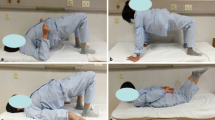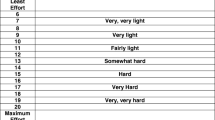Abstract
The objective of exercise in the treatment of osteoporosis is to improve axial stability through improvement of muscle strength. Therefore, a back extension exercise program specific to one’s musculoskeletal competence and pain can be performed in a sitting position and later advanced to the prone position. When fragility is resolved, back extension is performed against resistance applied to the upper back. To decrease pain and immobility in acute vertebral fracture, use of spinal orthoses become inevitable. Therapeutic exercise should address osteoporosis-related deformities of axial posture, which can increase risk of fall and fracture. Strengthening of the major appendicular muscles decreases fragility. The effect of strengthening exercise is augmented by proper intake of cholecalciferol and calcium. Thus, the role of a therapeutic exercise program is to increase muscle strength safely, decrease immobility-related complications, and prevent fall and fracture. As with pharmacotherapy, therapeutic exercises are individualized.



Similar content being viewed by others
References
Papers of particular interest, published recently, have been highlighted as:• Of importance •• Of major importance
Sinaki M: Prevention and treatment of osteoporosis. Physical Medicine and Rehabilitation, edn 2. In Edited by Braddom RL. Philadelphia: W.B. Saunders Company; 2000:894–912.
Sinaki M: Postmenopausal spinal osteoporosis: physical therapy and rehabilitation principles. Mayo Clin Proc 1982, 57:699–703.
de Kam D, Smulders E, Weerdesteyn V, Smits-Engelsman BC: Exercise interventions to reduce fall-related fractures and their risk factors in individuals with low bone density: a systematic review of randomized controlled trials. Osteoporos Int 2009, 20:2111–2125.
Sinaki M, Mikkelsen BA: Postmenopausal spinal osteoporosis: flexion versus extension exercises. Arch Phys Med Rehabil 1984, 65:593–596.
Ekin JA, Sinaki M: Vertebral compression fractures sustained during golfing: report of three cases. Mayo Clin Proc 1993, 68:566–570.
Sinaki M, Wahner HW, Offord KP, Hodgson SF: Efficacy of nonloading exercises in prevention of vertebral bone loss in postmenopausal women: a controlled trial. Mayo Clin Proc 1989, 64:762–769.
Sinaki M, Brey RH, Hughes CA, et al.: Significant reduction in risk of falls and back pain in osteoporotic-kyphotic women through a Spinal Proprioceptive Extension Exercise Dynamic (SPEED) program. Mayo Clin Proc 2005, 80:849–855.
Sinaki M: Relationship of muscle strength of back and upper extremity with level of physical activity in healthy women. Am J Phys Med Rehabil 1989, 68:134–138.
Sinaki M, Limburg PJ, Wollan PC, et al.: Correlation of trunk muscle strength with age in children 5 to 18 years old. Mayo Clin Proc 1996, 71:1047–1054.
Sinaki M, Nwaogwugwu NC, Phillips BE, Mokri MP: Effect of gender, age, and anthropometry on axial and appendicular muscle strength. Am J Phys Med Rehabil 2001, 80:330–338.
Melton LJ 3rd, Khosla S, Atkinson EJ, et al.: Cross-sectional versus longitudinal evaluation of bone loss in men and women. Osteoporos Int 2000, 11:592–599.
Sinaki M: Musculoskeletal challenges of osteoporosis. Aging Clin Exp Res 1998, 10:249–262.
Pfeifer M, Sinaki M, Geusens P, et al.: Musculoskeletal rehabilitation in osteoporosis: a review. J Bone Miner Res 2004, 19:1208–1214.
•• Pfeifer M, Begerow B, Minne HW, et al.: Effects of a long-term vitamin D and calcium supplementation on falls and parameters of muscle function in community-dwelling older individuals. Osteoporos Int 2009, 20:315–322. The significance of vitamin D supplementation and calcium intake for reduction in risk of falls has become more defined during recent years. The above reference supports that fact.
Sinaki M, Brey RH, Hughes CA, et al.: Balance disorder and increased risk of falls in osteoporosis and kyphosis: significance of kyphotic posture and muscle strength. Osteoporos Int 2005, 16:1004–1010.
Itoi E: Roentgenographic analysis of posture in spinal osteoporotics. Spine 1991, 16:750–756.
Itoi E, Sakurai M, Mizunashi K, et al.: Long-term observations of vertebral fractures in spinal osteoporotics. Calcif Tissue Int 1990, 47:202–208.
Sinaki M, Wollan PC, Scott RW, Gelczer RK: Can strong back extensors prevent vertebral fractures in women with osteoporosis? Mayo Clin Proc 1996, 71:951–956.
Lynn SG, Sinaki M, Westerlind KC: Balance characteristics of persons with osteoporosis. Arch Phys Med Rehabil 1997, 78:273–277.
• Ishikawa Y, Miyakoshi N, Kasukawa Y, et al.: Spinal curvature and postural balance in patients with osteoporosis. Osteoporos Int 2009, 20:2049–2053. This paper supports earlier studies on the influence of postural changes in individuals with osteoporosis who have kyphosis, which increased both their difficulty with equilibrium and their propensity for falls.
• Kasukawa Y, Miyakoshi N, Hongo M, et al.: Relationships between falls, spinal curvature, spinal mobility and back extensor strength in elderly people. J Bone Miner Metab 2010, 28:82–87. This study also reports on the effect of posture on risk of falls, in that the angles of lumbar kyphosis, spinal inclination, and postural imbalance were significantly greater in the falls group than in the nonfalls group.
Itoi E, Sinaki M: Effect of back-strengthening exercise on posture in healthy women 49 to 65 years of age. Mayo Clin Proc 1994, 69:1054–1059.
Sinaki M, Itoi E, Wahner HW, et al.: Stronger back muscles reduce the incidence of vertebral fractures: a prospective 10 year follow-up of postmenopausal women. Bone 2002, 30:836–841.
Hara S, Kishimoto K, Itoi E: Effects of Vitamin D3 Supplementation on Back Muscle Strength Gained By Back Muscle Exercise. Paper presented at the American Society for Bone and Mineral Research. Denver, CO; September 11–15, 2009.
•• Hongo M, Itoi E, Sinaki M, et al.: Effect of low-intensity back exercise on quality of life and back extensor strength in patients with osteoporosis: a randomized controlled trial. Osteoporos Int 2007, 18:1389–1395. The above reference evaluates modification of the initial study from Mayo Clinic for back-strengthening exercise. The paper substantiates that the exercise used in the initial 1989 study was the most effective one for improving back extensor strength.
Sinaki M, Grubbs NC: Back strengthening exercises: quantitative evaluation of their efficacy for women aged 40 to 65 years. Arch Phys Med Rehabil 1989, 70:16–20.
Frost HM: A determinant of bone architecture: the minimum effective strain. Clin Orthop Relat Res 183, 175:286–292.
•• Sinaki M: The role of physical activity in bone health: a new hypothesis to reduce risk of vertebral fracture. Phys Med Rehabil Clin N Am 2007, 18:593–608. In this reference, the new hypothesis based on our earlier study results is initiated—that nonloading back extension exercises decreased the incidence of vertebral fractures. This hypothesis reflects that back resistive exercises from a prone position would improve vertebral horizontal trabeculae, which can decrease risk of vertebral fracture and vertical loading.
Sinaki M: Critical appraisal of physical rehabilitation measures after osteoporotic vertebral fracture. Osteoporos Int 2003, 14:773–779.
Pfeifer M, Begerow B, Minne HW: Effects of a new spinal orthosis on posture, trunk strength, and quality of life in women with postmenopausal osteoporosis: a randomized trial. Am J Phys Med Rehabil 2004, 83:177–186.
Kaplan RS, Sinaki M, Hameister M: Effect of back supports on back strength in patients with osteoporosis: a pilot study. Mayo Clin Proc 1996, 71:235–241.
Sinaki M: Falls, fractures, and hip pads. Curr Osteoporos Rep 2004, 2:131–137.
Meurman KO, Elfving S: Stress fracture in soldiers: a multifocal bone disorder: a comparative radiological and scintigraphic study. Radiology 1980, 134:483–487.
Sinaki M, McPhee MC, Hodgson SF, et al.: Relationship between bone mineral density of spine and strength of back extensors in healthy postmenopausal women. Mayo Clin Proc 1986, 61:116–122.
Bischoff-Ferrari HA, Dietrich T, Orav EJ, et al.: Higher 25-hydroxyvitamin D concentrations are associated with better lower-extremity function in both active and inactive persons aged > or =60 y. Am J Clin Nutr 2004, 80:752–758.
Marshall D, Johnell O, Wedel H: Meta-analysis of how well measures of bone mineral density predict occurrence of osteoporotic fractures. BMJ 1996, 312:1254–1259.
van Staa TP, Geusens P, Kanis JA, et al.: A simple clinical score for estimating the long-term risk of fracture in post-menopausal women. QJM 2006, 99:673–682.
Lee MS, Pittler MH, Shin BC, Ernst E: Tai chi for osteoporosis: a systematic review. Osteoporos Int 2008, 19:139–146.
Bergstrom I, Landgren B, Brinck J, Freyschuss B: Physical training preserves bone mineral density in postmenopausal women with forearm fractures and low bone mineral density. Osteoporos Int 2008, 19:177–183.
Disclosure
No potential conflicts of interest relevant to this article were reported.
Author information
Authors and Affiliations
Corresponding author
Rights and permissions
About this article
Cite this article
Sinaki, M., Pfeifer, M., Preisinger, E. et al. The Role of Exercise in the Treatment of Osteoporosis. Curr Osteoporos Rep 8, 138–144 (2010). https://doi.org/10.1007/s11914-010-0019-y
Published:
Issue Date:
DOI: https://doi.org/10.1007/s11914-010-0019-y




